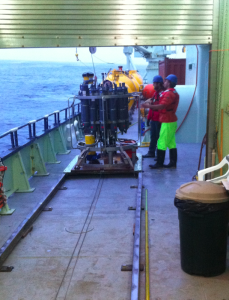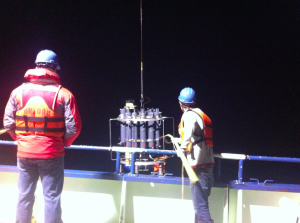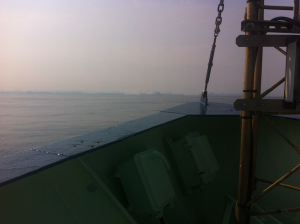The Knorr never sleeps. So neither do the scientists on it — or at least not all at the same time. Between sunrise and sunset, two “watch standers” and one marine tech are engaged in a data-collection all-nighter.
Sunday was the fifth night shift of our cruise, the night of the full, close-to-Earth moon, and the night that I chose to sit in. Close to Greenland, we were cruising over the continental shelf: the water is a little shallower here, the currents more interesting, and the work of the watch standers faster-paced.
The primary job of the watch standers is to usher a heavy and expensive instrument — called a CTD rosette, for its shape — to the bottom of the ocean. When watch standers Robert Daniels and Mironov Illarion take over at 8 PM, the thing is about 1,000 meters underwater, and rising at 60 meters/minute. Every couple hundred meters it stops, they hit a button that says “fire bottle” on the screen, and it closes one of its grey tubes to add 10 liters of ocean water to its load. Then one of them will press “talk” on a speaker box and tell an operator to bring the rosette up to a new height. Along its journey, sensors on the rosette measure the salinity, temperature, and density of the water: the “fingerprint” of a current. A lab tech, Elizabeth Bonk, will analyze the salt samples collected by the bottles.
This procedure — a CTD cast — is a staple of oceanography. Illarion and Daniels have both done the casts before — Illarion in the Arctic, and Daniels off the Bering straight. The CTD data they collect here will contribute to a high-resolution snapshot of what the current around Greenland is doing.
Creating this snapshot is, for now, an act of construction work. Illarion and Daniels have showed up to work in steel-toe boots; they add hard hats and orange life-vests to their safety ensemble. (Illarion is also wearing neon yellow overalls, his own sartorial contribution to the “safety” look.) When the rosette returns to the surface, we go outside, and stand on the deck. It is 50 degrees, plus wind chill. Nicholas Matthews, the marine tech on duty tells me to stand inside the garage or put on a hard hat — so he doesn’t get in trouble.
The rosette, on its wire line, emerges from the water. The watch standers hook the metal frame of the rosette with poles longer than they are tall. From a control room above, an operator recoils the wire, and retracts the metal beam that it is hooked on so the rosette swings onto the deck of the boat, and lowers onto a little wooden platform. The watch standers strap it in, and then, with the pull of a lever, the platform moves the rosette from the deck into a little garage, where I am standing. Beneath the light of a heat lamp, Illarion sprays the frame down with a fresh water hose. He and Daniels collect salt samples from each of the six bottles that they fired during the cast.
We go back inside, and then, maybe half an hour buy lasix online later return to the deck-garage to do the reverse: the watch standers move the rosette onto the deck, unstrap it, and the operator lifts it into the ocean. From the control room, we wait for this piece of machinery — which, for all the world, looks like Iron Man’s heart or a slice of a particle collider — to make its way to the bottom of the sea.
We will do this several times over the course of the night, watching screens and data in between the mechanical procedures. Though analysis will be performed later, we can see, between the difference between the amount of line that has been extended and the distance that the rosette has left to travel, that the current is swift here.
I am struck at once by the slowness of the routine — in eight hours, I could file three blog posts on trending news, complete an interview with a scientist, and watch an episode of The Mindy Project — and the immediacy: we are moving over the continental shelf, quite literally capturing cool, salty, pieces of the currents that run over it. Even tonight, when we are performing more casts than usual on account of our position over the shelf, there is lots of down time. We make jokes, popcorn; learn bits of English (Illarion) and Russian (Daniels and me).
By 1:00 am, the view out the window is pitch black. “For all we know the zombie apocalypse has happened and we are the only humans left on Earth.” says Mathews. This is true, I suppose, of any moment in the trip, but it feels particularly possible now. The lab is empty except for us four, a tech who is analyzing the salt samples, and one other scientist, playing music from his computer. (At some point I pause from my note taking to acknowledge that the sound of Brittany Spears’ “hit me baby one more time” is ricocheting around the deserted lab.)
The apocalypse-illusion is easily broken by the internet (The connection is too slow to be on constantly, but I’m too addicted to stay off for more than a couple hours.) I see that “super moon” is trending on Facebook.
We make a trip to the deck retrieve the rosette some time after 1:00 am. It’s foggy, but when the clouds part occasionally giving us glimpses of the pretty moon. Slices of silver appear on the pitch-black water. The water is the same color as the sky. The reflected moon beams, alongside seagulls, appear to float in mid-air. The boat starts moving to the next station — a quick handful of kilometers away — and the moon rolls around in the sky.
True to every all-nighter I’ve participated in, I get so tired I can hardly keep my eyes open. In spite of Roberts insistence that things are just getting fun, I tap out just before his time on the clock is over. As I’m lying in bed, I hear my roommate wakes up and rustles around, preparing for her 4:00 am shift. The Knorr never sleeps.


